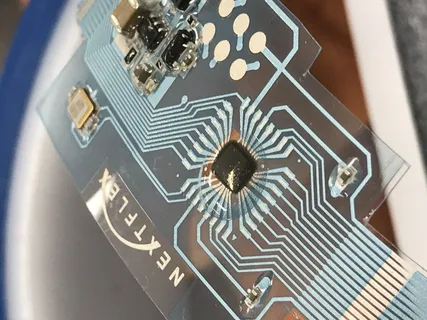The Evolution of Flexible Electronics transformative turn

Introduction
The evolution of electronics has taken a transformative turn with the emergence of flexible electronics, marking a departure from rigid and bulky devices. Flexible electronics represent a paradigm shift, offering versatility and adaptability that open new possibilities across various industries. This article explores the evolution, applications, and promising future of flexible electronics.
Flexible Substrates
At the core of flexible electronics is the use of flexible substrates that replace traditional rigid materials like silicon. Flexible substrates, often made of polymers, enable the creation of electronic components that can bend, twist, and conform to unconventional shapes without compromising functionality. This shift in materials has paved the way for a new era of lightweight and adaptable devices.
Printed Electronics
Printed electronics have played a crucial role in the evolution of flexibility. The ability to print electronic components on flexible substrates using techniques like inkjet printing and screen printing allows for cost-effective and scalable manufacturing. This innovation facilitates the mass production of flexible electronic devices, making them more accessible to a broader market.
Wearable Electronics
One of the prominent applications of flexible electronics is in the realm of wearable devices. Flexible sensors and circuits seamlessly integrate into clothing, allowing for the development of smart textiles. From fitness trackers to smart garments with health-monitoring capabilities, wearable electronics are enhancing the way we interact with technology.
Foldable Displays
The evolution of flexible electronics has given rise to foldable displays in smartphones and other electronic devices. These displays utilize flexible OLED (Organic Light Emitting Diode) technology, enabling users to unfold or fold their devices for a larger or more compact screen, respectively. This innovation enhances portability and user experience in mobile technology.
Medical Devices
Flexible electronics hold immense potential in the field of medical devices. Flexible sensors can conform to the contours of the human body, enabling non-invasive monitoring and diagnostics. From flexible patches that monitor vital signs to implantable devices, the adaptability of flexible electronics is revolutionizing healthcare.
Material Durability
Ensuring the durability of flexible materials over time is a key challenge. Constant bending and stretching may lead to material fatigue and wear. Researchers are actively exploring durable and resilient materials that can withstand the mechanical stress associated with flexible electronics, ensuring longevity and reliability.
Integration of Components
The integration of complex electronic components, such as processors and batteries, in a flexible form factor presents engineering challenges. Innovations in materials science and electronics engineering are focused on developing flexible components that maintain performance while accommodating the mechanical deformations inherent in flexible devices.
Internet of Things (IoT) Revolution
Flexible electronics are poised to play a pivotal role in the Internet of Things (IoT) revolution. The adaptability of flexible sensors and circuits makes them ideal for integration into a myriad of IoT devices, from smart home systems to industrial sensors. This seamless integration will contribute to the growth and expansion of the interconnected world.
Sustainable Electronics
The evolution of flexible electronics aligns with the growing emphasis on sustainability in technology. Flexible materials, particularly those derived from eco-friendly polymers, contribute to the development of more sustainable electronic devices. This shift towards sustainable electronics reflects a broader commitment to reducing environmental impact.
Conclusion
The evolution of flexible electronics marks a significant leap forward in the world of technology, offering a departure from rigid designs and opening doors to a new era of adaptability. From wearable devices to medical applications, the versatility of flexible electronics is reshaping industries and enhancing user experiences. As researchers address challenges and continue to innovate, the future holds the promise of even more advanced and ubiquitous flexible electronic devices.
FAQs
What are flexible substrates in the context of flexible electronics?
Flexible substrates are materials, often made of polymers, that replace traditional rigid materials like silicon in flexible electronics. These substrates enable the creation of electronic components that can bend, twist, and conform to unconventional shapes without compromising functionality.
How do printed electronics contribute to the evolution of flexible electronics?
Printed electronics play a crucial role in the evolution of flexible electronics by allowing the printing of electronic components on flexible substrates using techniques like inkjet printing and screen printing. This enables cost-effective and scalable manufacturing, facilitating the mass production of flexible electronic devices.
What are some applications of flexible electronics in the medical field?
Flexible electronics have applications in the medical field, particularly in the development of wearable medical devices. Flexible sensors can conform to the contours of the human body, enabling non-invasive monitoring and diagnostics. This adaptability is revolutionizing healthcare technologies.









